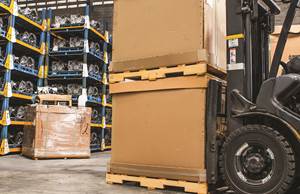PP Prices Drop While Others Rise
Domestic resin demand was moderate to slow in the second quarter, but exports were booming and many feedstock prices were rising.
Domestic resin demand was moderate to slow in the second quarter, but exports were booming and many feedstock prices were rising. The result is more price hikes for most commodity resins, the big exception being polypropylene, which actually dropped in price.
PE prices on the way up
Some PE suppliers pushed their 5¢/lb increase from June to July 1, while others tried to implement the hike right away. Some industry sources expect more efforts to raise prices soon. Meanwhile, the London Metal Exchange (LME) short-term futures contract for July in blown film butene LLDPE sold at 55.1¢/lb, up from June’s 54¢.
Contributing factors: Supplier inventories for LDPE and HDPE are said to be very low. Ethylene monomer supply is leaning toward tightness. Ethylene moved up 4¢/lb in April and May. Analysts expect another 1¢ to 2¢ rise in June.
Resin suppliers did not see the usual seasonal surge in PE demand in the second quarter, but they are encouraged by gradual month-to-month improvements. Says one, “Domestic sales from January to May were down 1.3%—250 million lb—from 2006. But PE resin exports were up 31%, or 750 million lb, which puts us ahead by 450 million lb in total sales.”
Says Mike Burns, managing partner at resin-purchasing consultant Resin Technology, Inc. (RTI) in Fort Worth, Texas, “We see further opportunity for LDPE and HDPE exports. So we are telling our customers that PE prices will hold. Despite generally lackluster domestic demand for PE goods, we are suggesting that they buy a little extra resin if they can this month.” Burns notes that any ethylene monomer production disruption or upsurge in ethylene demand from the PVC construction sector could tighten the screws on feedstock supply. He and other industry sources don’t expect any decline in PE prices this summer.
PP prices slump
PP contract prices were expected to fall 2¢ to 2.5¢/lb last month after a drop of 5¢ to 6¢/lb in spot resin prices in May. LME’s July futures contract for g-p injection-grade homopolymer sold at 55.4¢, down from June’s 58.1¢/lb.
Contributing factors: PP tabs have followed propylene monomer contract prices, which rose 13¢/lb through May and then dropped 2.5¢ in June. Industry sources say monomer could fall another 2.5¢ to 3¢/lb in July and August. “There is no guarantee that July monomer contracts will drop,” cautions RTI managing partner Scott Newell, “because refineries have not been running well and propylene inventories have dropped. They are vulnerable to any major production disruption.”
While domestic PP demand has been flat or slightly negative, exports soared 240% in January to April over last year. Resin plant utilization rates are 90% to 95%, while inventories are 10 to 15 days below normal.
PVC prices on the rise
PVC producers all supported a 2¢ increase for June. Georgia Gulf led a further 2¢ hike for July 1, but it had no followers as of mid-June. Several large PVC compounders also announced increases on rigid and flexible compounds totaling 7¢ to 8¢/lb from March to June.
PS hikes cause confusion
Dow split its May increase, allowing processors a choice of swallowing a 5¢ hike for the whole month or just 3¢ until May 15 and 7¢ thereafter. That left some processors paying 2¢/lb more than others at the end of May. Dow and most other suppliers announced a further 3¢ hike for June, while Total posted only a 2¢ increase. The result is some confusion over where prices stand.
Contributing factors: May PS demand was the strongest yet this year. June was slightly lower, but still good. June may have seen the PS price peak for a while. Benzene feedstock contract price is $4/gal, down from $4.20, but spot benzene in mid-June was $3.60 to $3.70/gal.
More price increases
- Ticona raised PET and PBT 12¢ on July 2.
- Rhodia hiked nylon 6 and 66 by 7¢ to 7.5¢/lb.
- Lubrizol’s Estane TPUs cost 14¢/lb more on July 13.
- Thermoset polyesters, vinyl esters, and gel coats rose for a second month in a row. AOC, CCP, Interplastic, and Reichhold hiked tabs 7¢/lb early this month.
| Market Prices Effective Mid-June A |
|
|
KEY: Colored areas indicate pricing activity. An arrow () indicates direction of price change. aTruckload, unless otherwise specified. bUnfilled, natural color, unless otherwise specified. cBased on typical or average density. dNot applicable. eNovolac and anhydride grades for coils, bushings, transformers. fNovolac and anhydride grades for resisitors, capacitors, diodes. gIn quantities of 20,000 lb. h19,800-lb load. jLME 30-day futures contract for lots of 54,564 lb.. |
Related Content
Scaling Up Sustainable Solutions for Fiber Reinforced Composite Materials
Oak Ridge National Laboratory's Sustainable Manufacturing Technologies Group helps industrial partners tackle the sustainability challenges presented by fiber-reinforced composite materials.
Read MoreThe Fantasy and Reality of Raw Material Shelf Life: Part 1
Is a two-year-old hygroscopic resin kept in its original packaging still useful? Let’s try to answer that question and clear up some misconceptions.
Read MoreAutomotive Awards Highlight ‘Firsts,’ Emerging Technologies
Annual SPE event recognizes sustainability as a major theme.
Read MoreGeneral Polymers Thermoplastics to Further Expand Distribution Business
NPE2024: Following the company’s recent partnership buyout, new North American geographic territories are in its sight.
Read MoreRead Next
People 4.0 – How to Get Buy-In from Your Staff for Industry 4.0 Systems
Implementing a production monitoring system as the foundation of a ‘smart factory’ is about integrating people with new technology as much as it is about integrating machines and computers. Here are tips from a company that has gone through the process.
Read MoreMaking the Circular Economy a Reality
Driven by brand owner demands and new worldwide legislation, the entire supply chain is working toward the shift to circularity, with some evidence the circular economy has already begun.
Read More












